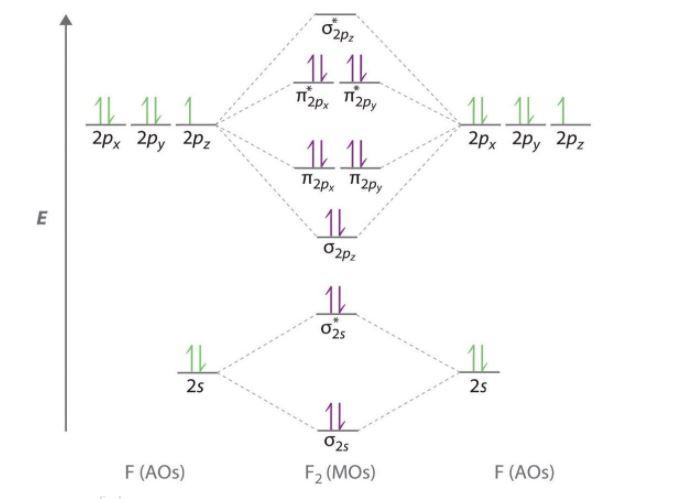
Draw molecular orbital diagram for ${{F}_{2}}$ molecule. Also, gives its electronic configuration, bond order and magnetic property.
Answer
520.8k+ views
Hint: The Molecular Orbital Theory (MOT) explains the formation of the molecule in a better way than Valence Bond Theory (VBT).
The bond order calculations are feasible using MOT and so is the description of electronic configuration. Thus, the magnetic property can be explained when we know electronic configuration of molecules.
Complete step by step solution:
-Before solving the illustration given let us see about the VBT, MOT, bond order and magnetic property relations.
-MOT and VBT are the foundational theories of quantum chemistry. The VBT gives a more understandable pictorial representation of molecules but, MOT explains the molecular formation in a better way. MOT describes the electronic structure of molecules using quantum mechanics.
-According to MOT, the atomic orbitals of comparable energy undergo overlap and give the formation of the same number of molecular orbitals.
-Addition of atomic orbitals- The atomic orbitals with the same sign combine to give bonding molecular orbitals. In the molecular orbital, the region between the two nuclei is the place where there is overlap of individual orbitals. Hence, there is greater probability of electron density in this region.
-MOT uses a linear combination of atomic orbitals strategy to represent molecular orbitals resulting from bonds between atoms. These are bonding, anti-bonding and non-bonding.
-Magnetic character- If all the electrons in the molecule of a substance are paired, then the substance is diamagnetic i.e. can be repelled by the magnetic field. Whereas, presence of unpaired electrons shows that the substance is paramagnetic i.e. can be attracted by magnetic field. Now, let us see the MO diagram of ${{F}_{2}}$ molecule-

-Molecular orbital electronic configuration is given by,
MOEC = $KK{{\left( \sigma 2s \right)}^{2}}{{\left( {{\sigma }^{*}}2s \right)}^{2}}{{\left( \sigma 2{{p}_{z}} \right)}^{2}}\left[ {{\left( \pi 2{{p}_{x}} \right)}^{2}}={{\left( \pi 2{{p}_{y}} \right)}^{2}} \right]\left[ {{\left( {{\pi }^{*}}2{{p}_{x}} \right)}^{2}}={{\left( {{\pi }^{*}}2{{p}_{y}} \right)}^{2}} \right]$
-where, KK denotes ${{\left( \sigma 1s \right)}^{2}}{{\left( {{\sigma }^{*}}1s \right)}^{2}}$
-Bonding orbitals are $\sigma 2s,\sigma 2{{p}_{z}},\pi 2{{p}_{x}},\pi 2{{p}_{y}}$
-Anti-bonding orbitals are ${{\sigma }^{*}}2s,{{\sigma }^{*}}2{{p}_{z}},{{\pi }^{*}}2{{p}_{x}},{{\pi }^{*}}2{{p}_{y}}$
-Therefore, Bond order = $\dfrac{{{N}_{b}}-{{N}_{a}}}{2}$
-Here, ${{N}_{b}}$ denotes number of electrons in bonding molecular orbitals
${{N}_{a}}$ denotes number of electrons in antibonding molecular orbitals
-So, Bond order of ${{F}_{2}}$ = $\dfrac{8-6}{2}=1$
-Since, all the electrons in the molecular orbitals are paired, it is diamagnetic.
Note: The bonding MO has lower energy and hence greater stability whereas, anti-bonding MO has more energy and hence lesser stability. That is why, electrons will be added or removed from antibonding orbitals first forming an ion.
The bond order calculations are feasible using MOT and so is the description of electronic configuration. Thus, the magnetic property can be explained when we know electronic configuration of molecules.
Complete step by step solution:
-Before solving the illustration given let us see about the VBT, MOT, bond order and magnetic property relations.
-MOT and VBT are the foundational theories of quantum chemistry. The VBT gives a more understandable pictorial representation of molecules but, MOT explains the molecular formation in a better way. MOT describes the electronic structure of molecules using quantum mechanics.
-According to MOT, the atomic orbitals of comparable energy undergo overlap and give the formation of the same number of molecular orbitals.
-Addition of atomic orbitals- The atomic orbitals with the same sign combine to give bonding molecular orbitals. In the molecular orbital, the region between the two nuclei is the place where there is overlap of individual orbitals. Hence, there is greater probability of electron density in this region.
-MOT uses a linear combination of atomic orbitals strategy to represent molecular orbitals resulting from bonds between atoms. These are bonding, anti-bonding and non-bonding.
-Magnetic character- If all the electrons in the molecule of a substance are paired, then the substance is diamagnetic i.e. can be repelled by the magnetic field. Whereas, presence of unpaired electrons shows that the substance is paramagnetic i.e. can be attracted by magnetic field. Now, let us see the MO diagram of ${{F}_{2}}$ molecule-

-Molecular orbital electronic configuration is given by,
MOEC = $KK{{\left( \sigma 2s \right)}^{2}}{{\left( {{\sigma }^{*}}2s \right)}^{2}}{{\left( \sigma 2{{p}_{z}} \right)}^{2}}\left[ {{\left( \pi 2{{p}_{x}} \right)}^{2}}={{\left( \pi 2{{p}_{y}} \right)}^{2}} \right]\left[ {{\left( {{\pi }^{*}}2{{p}_{x}} \right)}^{2}}={{\left( {{\pi }^{*}}2{{p}_{y}} \right)}^{2}} \right]$
-where, KK denotes ${{\left( \sigma 1s \right)}^{2}}{{\left( {{\sigma }^{*}}1s \right)}^{2}}$
-Bonding orbitals are $\sigma 2s,\sigma 2{{p}_{z}},\pi 2{{p}_{x}},\pi 2{{p}_{y}}$
-Anti-bonding orbitals are ${{\sigma }^{*}}2s,{{\sigma }^{*}}2{{p}_{z}},{{\pi }^{*}}2{{p}_{x}},{{\pi }^{*}}2{{p}_{y}}$
-Therefore, Bond order = $\dfrac{{{N}_{b}}-{{N}_{a}}}{2}$
-Here, ${{N}_{b}}$ denotes number of electrons in bonding molecular orbitals
${{N}_{a}}$ denotes number of electrons in antibonding molecular orbitals
-So, Bond order of ${{F}_{2}}$ = $\dfrac{8-6}{2}=1$
-Since, all the electrons in the molecular orbitals are paired, it is diamagnetic.
Note: The bonding MO has lower energy and hence greater stability whereas, anti-bonding MO has more energy and hence lesser stability. That is why, electrons will be added or removed from antibonding orbitals first forming an ion.
Recently Updated Pages
The number of solutions in x in 02pi for which sqrt class 12 maths CBSE

Write any two methods of preparation of phenol Give class 12 chemistry CBSE

Differentiate between action potential and resting class 12 biology CBSE

Two plane mirrors arranged at right angles to each class 12 physics CBSE

Which of the following molecules is are chiral A I class 12 chemistry CBSE

Name different types of neurons and give one function class 12 biology CBSE

Trending doubts
What is 1s 2s 2p 3s 3p class 11 chemistry CBSE

Discuss the various forms of bacteria class 11 biology CBSE

An example of chemosynthetic bacteria is A E coli B class 11 biology CBSE

Name the metals and nonmetals in the first twenty class 11 chemistry CBSE

Which one of the following is not a method of soil class 11 biology CBSE

What is the nature of force between two parallel conductors class 11 physics CBSE




